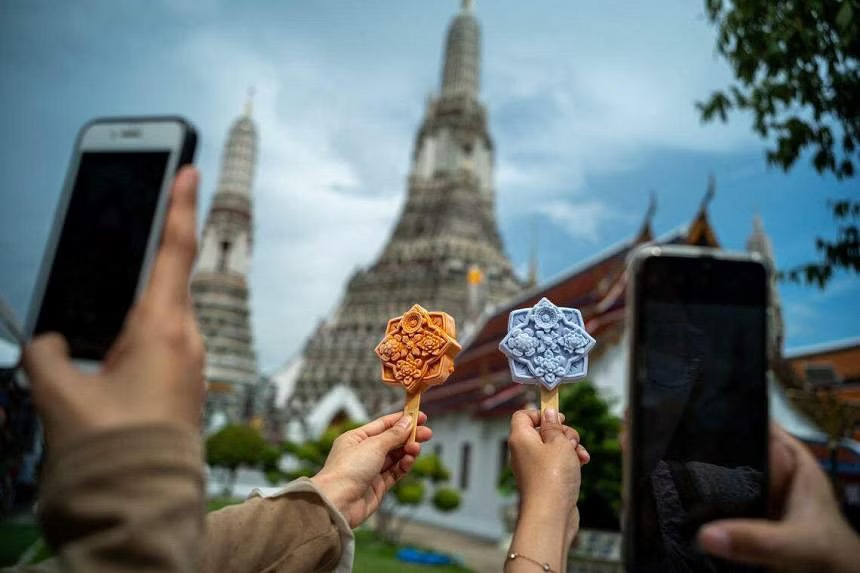Indian tourists flock to South-east Asia as China's reopening falters


NEW DELHI - Indian tourists are streaming into South-east Asia, cementing the world's most populous country's position as a key growth market for a travel and tourism sector that is feeling the pinch of China's slower-than-expected reopening.
From airlines like IndiGo and Thai Airways to hospitality chains offering thousands of rooms, companies are tapping into India's burgeoning middle-class and growing spending power, executives and analysts said.
"South-east Asia is obviously very well positioned for a lot of the growth that is inevitably going to come from India," aviation analyst Brendan Sobie told an industry conference in June.
The travel and tourism industry is critical for several South-east Asian economies and contributed about 12 per cent of the region's gross domestic product before the Covid-19 pandemic.
It also employs more than 40 million of the region's people, according to the Organisation for Economic Cooperation and Development.
For a decade or so the sector was fuelled by China, but official data from four South-east Asian countries shows a weak recovery with the number of Chinese visitors in May at least 60 per cent lower than the same month in 2019.
A long-term increase in Indian tourists would lead to a recalibration of airline capacity, hospitality offerings and tourism operators - early signs of which are under way, according to industry members.
[[nid:612766]]
India could emerge as the next China "in terms of outbound tourism growth" over the next decade, though connectivity would be constrained by fewer airports there, the Asian Development Bank said in a May report.
"India could become the story in the decade after the pandemic for tourism," it said.
In Thailand, where tourism is an economic mainstay, the number of Indian tourists - though fewer than Chinese in absolute terms - is only about 14 per cent lower than it was in 2019.
In 2019, Chinese visitors spent about US$197 (S$260) a day in Thailand and Indians spent about US$180, with both visiting for about a week, according to Thai government data.
Mr Tanes Petsuwan, deputy governor of the Tourism Authority of Thailand, said 1.6 million Indians were expected to visit the kingdom in 2023.
In May, more Indians than Chinese visited Singapore while that same month nearly 63,000 Indians visited Indonesia compared with just over 64,000 Chinese.
"Indian routes are very strong," said Mr Chai Eamsiri, chief executive officer of Thai Airways which is flying 14 flights a week to China - down from about 40 before the pandemic - and 70 a week to India.
Some of a possible doubling of Thai's narrow-body aircraft fleet over the next decade would be deployed to India, Mr Chai said.

Indian budget carrier IndiGo, which has ordered 500 Airbus narrow-body jets to meet regional demand, said it had seen a "strong uptick" in routes between India and South-east Asia that it connects with more than 100 flights a week.
"We are introducing flights to Jakarta in August, as well as additional frequencies to Singapore," said Mr Vinay Malhotra, IndiGo's head of global sales.
Overall, seat capacity on scheduled flights between China and South-east Asia was 57 per cent below pre-Covid-19 levels as at June, but flights from India to the region had recovered to about 90 per cent, Mr Sobie said.
Indians are helping to sustain a post-pandemic rebound for hospitality chains, including Minor Hotels, which has 45 properties in South-east Asia with more than 6,000 rooms.
"The Indian market is consistently one of our top source markets," said Chief Executive Officer (CEO) Dillip Rajakarier, adding that the hotel chain - part of Bangkok-listed Minor International - had intensified marketing across India.
In June, Mr Pratyush Tripathy and four friends hopped on a two and a half hour flight from the Indian city of Kolkata to Bangkok for a five-day holiday, much of it in and around the beach resort of Pattaya.

The trip cost between 40,000 Indian rupees and 60,000 Indian rupees (S$644 to $966) each, about the same as a flight to Europe, said Mr Tripathy.
"It will save you time and also money," said the 33-year-old software professional, explaining their decision to visit South-east Asia, where Indians can usually get visas much more easily than they can for European countries and the United States.
Flight bookings from India to Bangkok jumped by 270 per cent between January and June 2023 compared with the same period in 2019, according to Indian online travel portal Cleartrip.
Thailand's central bank expects 29 million visitors in 2023 and 35.5 million in 2024.
That is still fewer than a record of nearly 40 million in 2019, but the Bank of Thailand forecasts that the sector will help drive overall economic growth to 3.6 per cent in 2023 and 3.8 per cent in 2024, compared with 2.6 per cent in 2022.
To cash in on the surge, Thailand's tourist industry must understand Indians' preferences, particularly around food and entertainment, said Mr Somsong Sachaphimukh, vice-president of the Tourism Council of Thailand.
"If we don't adjust quickly, neighbouring countries will draw in those visitors," Mr Somsong said.
"Thailand has a lot to offer, so this is a big opportunity."
ALSO READ: Thailand looks to Indian weddings to boost tourism revenue